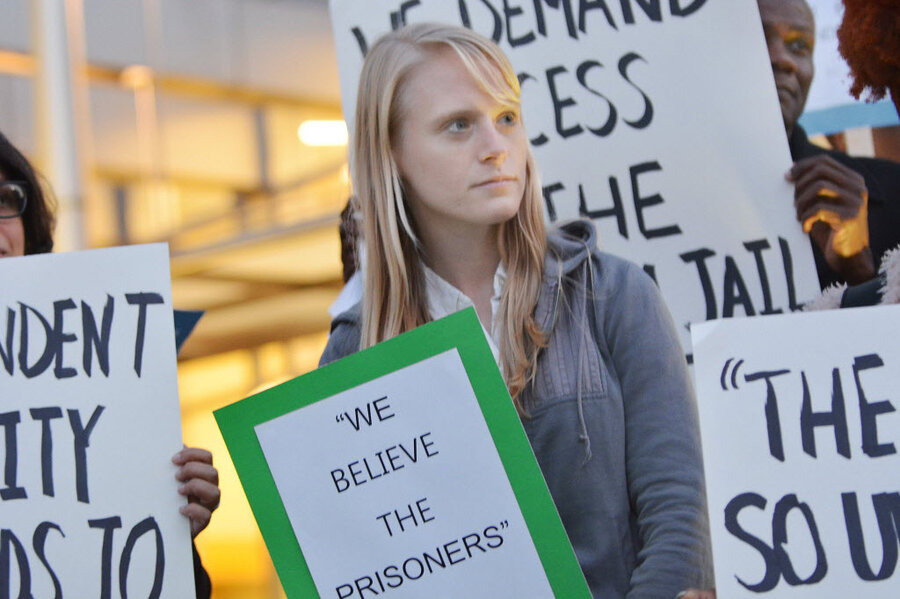As inmate ranks swell, counties choose: Bigger jails or fewer prisoners?
Loading...
Rapidly-growing populations in county jails have accelerated the country's dramatic increase in mass incarceration, according to a new analysis, exposing a little-discussed angle of America's prison system, which locks up more people than any other country in the world.
The Vera Institute of Justice's review of jail statistics from 1970 to today finds that prisoner rates in medium-sized counties (250,000 to 1 million residents) grew fourfold over that period, while small counties' rates grew sevenfold. In large counties, where urban jails often shape the public perception of prison policies, populations only grew threefold.
Whereas smaller counties held 28 percent of the nation's inmates in 1978, by 2014 they housed 44 percent.
Jails themselves are expanding, in part to accommodate longer sentences: while average jail time in 1978 was nine days, that's grown to 23 days today.
Bipartisan efforts to reform the prison system are making headway on Capitol Hill, where President Obama has pushed to change a system known for its cost — $80 billion each year — and disproportionate impact on communities of color: African-Americans are jailed at four times the rate of white suspects.
"Every dollar [the Justice Department has] to spend keeping nonviolent drug offenders in prison is a dollar they can’t spend going after drug kingpins, or tracking down terrorists, or hiring more police and giving them the resources that would allow them to do a more effective job community policing," Mr. Obama told NAACP leaders at the organization's annual conference in July.
The White House's push for change has focused on reducing or eliminating mandatory sentences for nonviolent drug offenses. In October, the Justice Department granted early release to 6,000 federal prisoners who had been jailed for low-level drug crimes.
At the county level, however, experts say there's no one-size-fits-all solution to reducing prison populations, leaving local jails deliberating over whether to expand their facilities to accommodate more, or focus on reducing incarceration in the first place.
"To understand what's going on you have to look at the local context," Nancy Fishman, project director at the Vera Institute's Center on Sentencing and Corrections, told the Associated Press. "A lot of the things we see, we don't have answers for yet."
"Everyone's jail problem is a little different," adds Vera's Christian Henrichson, but the report notes some possible trends: an uptick in traffic tickets and summonses, for instance, and reductions in mental health care.
Country jails often hold inmates with shorter sentences, or those awaiting trial, while many national efforts to reform incarceration focus on long-term inmates. Roughly 30 percent of the nation's inmates are housed in county jails, with another 57 percent in state prisons.
The Vera Institute hopes to help guide local jails' decisions with an interactive map of the nation's 3,000 counties, where administrators can compare their own area with others of similar size, demographics, and income.
"Jails are where mass incarceration begins, and reforming how we use them is critical to how we can end it," Vera's President Nicholas Turner said in a statement released Tuesday morning. "We look forward to using this critical tool with policymakers and other partners willing to join with us to end the country’s overreliance on jails."
Oklahoma City and Marion County, Ind., are just two counties debating the choice between bigger jails or fewer inmates, with some suggesting that improving mental health services and other opportunities could help reduce jail growth.
Education and community advocates often cite the so-called school-to-prison pipeline, highlighting how unequal treatment at school, and unequal school quality itself, drives crime rates.
"One study found that for every dollar we invest in pre-K, we save at least twice that down the road in reduced crime," Obama told the NAACP in July:
Getting a teenager a job for the summer costs a fraction of what it costs to lock him up for 15 years. Investing in our communities makes sense. It saves taxpayer money if we are consistent about it, and if we recognize that every child deserve opportunity — not just some, not just our own.
The stark choice local jails are facing – more jails, or jail less – prompts hard questions, says Ms. Fishman: "People don't think about the jail most of the time until these moments when the question is: Do we build another one? Then the question is, Wait a minute, how are we using our jails for in the first place?"
Meanwhile, counties are facing an increasing level of scrutiny when it comes to conditions and treatment of prisoners in their jails. The 3,000-inmate facility in Oklahoma City, for example, was cited for unconstitutional conditions by the Department of Justice in 2008, prompting its original plan to grow — a plan it's now reconsidering, as it weighs the benefits of investing more in crime prevention.
"Partly because of cameras, partly because of tragedy, partly because the statistics cannot be ignored, we can’t close our eyes anymore," Obama has said. "And the good news ... is that good people of all political persuasions are starting to think we need to do something about this."
This report contains material from the Associated Press.








